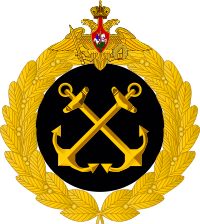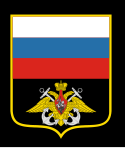| Russian Navy | |
|---|---|
| |
 Emblem of the Russian Navy | |
| Active |
|
| Country | Russia |
| Branch | Navy |
| Size | 160,000 active duty (2023)[2] Approx. 370 active ships[3] |
| Part of | Armed Forces of the Russian Federation |
| Headquarters | Admiralty building, Saint Petersburg |
| Motto(s) | "С нами Бог и Андреевский флаг!" (God and St. Andrew's flag are with us!) |
| March |
|
| Anniversaries | Navy Day (last Sunday in July) Submariner's Day (19 March) Surface Sailor's Day (20 October) |
| Fleet | 1 aircraft carrier (inactive) 2 battlecruisers 2 cruisers 10 destroyers 11 frigates 80 corvettes 11 landing ship tanks 60 landing craft 18 special-purpose ships 4 patrol ships 56 patrol boats 45 mine countermeasures vessels 8 special-purpose submarines 65 active ballistic missile/cruise missile and attack submarines[4] |
| Engagements | |
| Website | structure |
| Commanders | |
| Commander-in-Chief | Admiral Aleksandr Moiseyev (acting)[5] |
| First Deputy Commander-in-Chief | Admiral Aleksandr Nosatov |
| Deputy Commander-in-Chief | Vice-Admiral Vladimir Kasatonov |
| Insignia | |
| Ensign |  |
| Jack |  |
| Pennant | |
| Patch |  |
| Middle Emblem |  |
| Insignia |  |
The Russian Navy[a] is the naval arm of the Russian Armed Forces. It has existed in various forms since 1696. Its present iteration was formed in January 1992 when it succeeded the Navy of the Commonwealth of Independent States (which had itself succeeded the Soviet Navy following the dissolution of the Soviet Union in late December 1991).
The Imperial Russian Navy was established by Peter the Great (Peter I) in October 1696. The symbols of the Russian Navy, the St. Andrew's ensign (seen to the right), and most of its traditions were established personally by Peter I.
The Russian navy possesses the vast majority of the former Soviet naval forces, and currently comprises the Northern Fleet, the Pacific Fleet, the Black Sea Fleet, the Baltic Fleet, the Caspian Flotilla, the permanent task force in the Mediterranean, Naval Aviation, and the Coastal Troops (consisting of the Naval Infantry and the Coastal Missile and Artillery Troops).
The Russian navy suffered severely with the collapse of the Soviet Union due to insufficient maintenance, lack of funding, and subsequent effects on the training of personnel and timely replacement of equipment. Another setback was attributed to Russia's domestic shipbuilding industry, which was in decline due to the absence of modern hardware and technology.
In 2013, a rise in gas and oil prices enabled a sort of renaissance of the Russian Navy due to increased available funds, which may have allowed Russia to begin "developing the capacity to modernize".[6] In August 2014, Defence Minister Sergei Shoigu said that Russian naval capabilities would be bolstered with new weapons and equipment within the next six years in response to the enlargement of NATO and the beginning of the Russo-Ukrainian War.[7][needs update]
As of September 2024[update] the non-operational aircraft carrier Admiral Kuznetsov is the Russian Navy's only carrier leaving the Russian Navy without an operational aircraft carrier. Further, reports that the Admiral Kuznetsov's crew of ca. 1500 has been reassigned to the Russian Army for combat duty in Ukraine indicates that there is no plan to make the Russian Navy a carrier navy again.[8]
- ^ "Russian Armed Forces: Military Modernization and Reforms" (PDF). 20 July 2020. Archived (PDF) from the original on 4 August 2022. Retrieved 29 June 2022.
- ^ International Institute for Strategic Studies: The Military Balance 2014, p. 185.
- ^ Mizokami, Kyle (19 April 2018). "Here Are All the Submarines of the Russian Navy in One Infographic". Popular Mechanics. Archived from the original on 6 August 2020. Retrieved 6 September 2020.
- ^ "Russia confirms naval chief replaced after Black Sea failures". CNN. 19 March 2024. Retrieved 19 March 2024.
- ^ Fedyszyn, Thomas R. (March 2012). "Renaissance of the Russian Navy?". Proceedings. Vol. 138, no. 3/1, 309. United States Naval Institute. ISSN 0041-798X. Archived from the original on 30 July 2012. Retrieved 8 August 2012.
- ^ "Russia vows naval expansion to counter NATO; move in response to Ukraine tensions" Archived 21 August 2014 at the Wayback Machine, Washington Times (20 August 2014)
- ^ Axe, David (22 September 2024). "The Kremlin Pulled Sailors Off The Decrepit Aircraft Carrier 'Admiral Kuznetsov' And Sent Them To Fight, And Die, In Ukraine". forbes.com. Retrieved 24 October 2024.
Cite error: There are <ref group=lower-alpha> tags or {{efn}} templates on this page, but the references will not show without a {{reflist|group=lower-alpha}} template or {{notelist}} template (see the help page).